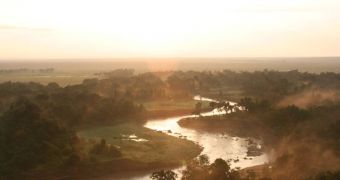Authorities in Tanzania have it in their minds to construct a new road in the northern parts of the country. That would be all well and good, if the road were not to pass through one of the world's largest and most important wildlife sanctuary.
The Serengeti National Park is one of the most renowned areas in the world, containing a large number of animals and plant species, including some that cannot be found anywhere else in the world.
Each year, millions of creatures of all shapes and sizes migrate in the Serengeti, heading from one of its end to another. This migration will be severely disrupted if the world is built.
As far as land animals go, this is the largest migration taking place anywhere on the planet. But the road that authorities are proposing is to cross the northern portion of Serengeti.
This means that the migration patterns would be severely disrupted, with potentially devastating consequences for the entire ecosystem in the national park, OurAmazingPlanet reports.
Arusha-Musoma is a highway that would cut northern Serengeti in two, producing a physical barrier preventing animals from crossing the road to get to the proverbial other side.
At this point, conservations are going out of their way to persuade authorities to at least consider finding alternative routes on which to set the road.
They recognize the critical role that such a highway would have for the development of the region, but add that destroying the Serengeti shouldn't be the price the area has to pay for this.
“The Serengeti is the site of one of the last great ungulate migrations left on Earth, the pre-eminent symbol of wild nature for millions of visitors and TV viewers, and a hugely important source of income for the people of Tanzania through ecotourism,” explains James Deutsch.
“To threaten this natural marvel with a road would be a tragedy,” adds the expert, who works for the Wildlife Conservation Society (WCS).
The group, along with colleagues from the Zoological Society London (ZSL), is leading the efforts to stop the destruction of Serengeti.
The conservationists explain that some of the rarest and most endangered species in the area include rhinos, elephants, cheetahs, lions, wild dogs and leopards. All these animals would stand to lose, or potentially go extinct, if Serengeti migrations are affected.
“We implore the Tanzanian government – known around the world for its commitment to conservation – to reconsider this proposal and explore other options,” Deutsch explains.
“A commercial road would not only result in wildlife collisions and human injuries, but would serve to fragment the landscape and undermine the ecosystem in a variety of ways,” Jonathan Baillie explains.
“To diminish this natural wonder would be a terrible loss for Tanzania and all future generations,” adds the expert, who is based at the ZSL.
Scientists who have been studying the park for many years say that there are other options available for the government to pursue, such as for example building the road elsewhere.
“We recognize that there is an obvious need for infrastructure development in Tanzania. A far better option than the current proposal is placing a road to the south of the park,” says Markus Borner.
“Such a road would be both cheaper to construct and would serve a much larger number of people without interrupting the migration and jeopardizing the iconic status of the Serengeti National Park,” concludes the expert, who is based at the Frankfurt Zoological Society.
He has been conducting research in Serengeti for the better part of half a century.

 14 DAY TRIAL //
14 DAY TRIAL //